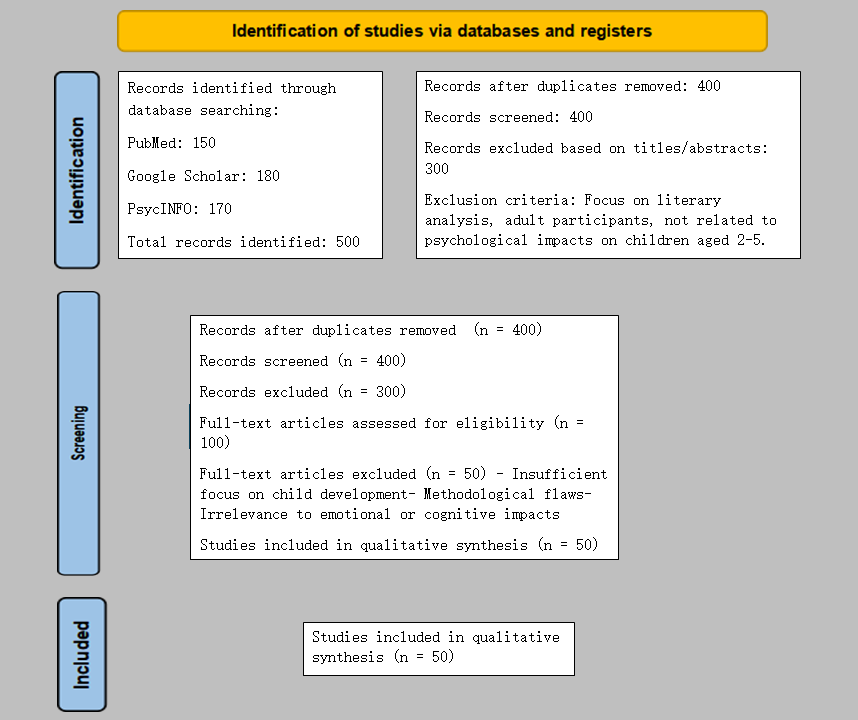Therapeutic and developmental benefits of fairy tales in early childhood: A mini-review
DOI:
https://doi.org/10.14295/bjs.v3i8.600Keywords:
pediatrics, psychology, occupational therapy, developmentalAbstract
The role of fairy tales in preschool-aged children's emotional and cognitive development is discussed. Separating good from evil makes it easier for children to cope with conflicting emotions. This encourages creative thinking and personality growth as representations of conscious and unconscious motifs in stories guide children through their thoughts. Fairy tales even provide secure, comforting, and supporting feelings though they relate to conflicts or endangerment themes, fostering positive self-image and emotional intelligence in kids. It was found that a happy ending to a fairy tale lessens tension, alleviates anxiety arising from developmental fears, and meets the need for justice among kids. Representation of negative characters in these stories contributes positively to emotional development. In Australia, research has shown that talking about fairy tales helps a child meet emotional needs, especially when told in groups with accompanying acting out. In addition, the article examines how therapeutic fairy tales can decrease fearfulness while dealing with actual life problems throughout this period. Moreover, the paper explores how fairy tales might be used as therapy to address anxiety as well as real-life conflicts during emotional development. Essential for appreciating children’s fantasies that can lead to internal conflicts because of their inability to express themselves in any other manner, it is pertinent for parents and their kids to have storytelling sessions where they can talk about anything. Lastly, fairy tales are sources of inspiration; they teach morals and values; tools necessary for mental growth, cognitive advancement, moral maturity, and creativity, making people think critically and interrogatively.
References
Adamski, S. (2011). Archetypes, collective unconscious, and quantum psychology. NeuroQuantology, 9(3), 563-571. DOI: https://doi.org/10.14704/nq.2011.9.3.413
Bettelheim, B. (1976). The uses of enchantment. New York: Alfred A. Knopf. DOI: https://doi.org/10.1037/e309842005-008
Breen, L. (2004). What if Santa died? Childhood myths and development. Psychiatric Bulletin, 28(12), 455-456. https://doi.org/10.1192/pb.28.12.455 DOI: https://doi.org/10.1192/pb.28.12.455
Collins, L. (2010). Autonomy and authorship: Storytelling in children's picture books. Hypatia: A Journal of Feminist Philosophy, 25(1), 174-195. https://doi.org/10.1111/j.1527-2001.2010.01090.x DOI: https://doi.org/10.1111/j.1527-2001.2010.01090.x
Danilewitz, D. (1991). Once upon a time..... The meaning and importance of fairy tales. Early Child Development and Care, 75(1), 87-98. https://doi.org/10.1080/0300443910750104 DOI: https://doi.org/10.1080/0300443910750104
Fleer, M., Hammer, M., & March, S. (2014). Theorising children’s learning in innovative contexts: Imagining new possibilities for early childhood education. New York: Springer.
Geist, E., & Aldridge, J. (2002). The developmental progression of children's oral story inventions. Journal of Instructional Psychology, 29(1), 33-40.
Koutsompou, V. I. (2016). The child and the fairy tale: The psychological perspective of children’s literature. International Journal of Languages, Literature and Linguistic, 2(4), 213-218. https://doi.org/10.18178/ijlll.2016.2.4.98 DOI: https://doi.org/10.18178/IJLLL.2016.2.4.98
Kulikovskaya, I. E., & Andrienko, A. A. (2016). Methodological approaches to the study of psychological readiness for school of children. Moscow: National Research University Higher School of Economics.
Ljovkina, A. (2018). Applying psycho-technical fairy tale to develop child’s logical thinking abilities: VII International Conference Early Childhood. Care and Education, 59, 64. https://doi.org/10.15405/epsbs.2018.07.9 DOI: https://doi.org/10.15405/epsbs.2018.07.9
Lubetsky, M. J. (1989). The development of moral reasoning in young children. New York: Plenum Press.
Mastrothanasis, K., & Papakosta, A. (2017). Διερεύνηση των αντιλήψεων των παιδιών σχετικά με πρακτικές αφηγηματικής δραστηριότητας στο σπίτι: Μια δημογραφική έρευνα για την αφήγηση παραμυθιών. Research Journal of the Academy of Pedagogical Sciences, 6(1), 198-213. https://doi.org/10.12681/hjre.14099 DOI: https://doi.org/10.12681/hjre.14099
Ratner, N. K., & Olver, R. R. (1998). The role of storytelling in early childhood education. London: Routledge.
Shapiro, R. B., & Katz, C. L. (1978). Fairy tales, splitting, and ego development. Contemporary Psychoanalysis, 14(4), 591-602. https://doi.org/10.1080/00107530.1978.10745565 DOI: https://doi.org/10.1080/00107530.1978.10745565
Stein, N. L. (1982). The development of social cognition in early childhood. New York: Academic Press.
Strayer, J. (1995). Children’s and adults’ responses to fairy tales. Early Child Development and Care, 113(1), 1-17. https://doi.org/10.1080/0300443951130101 DOI: https://doi.org/10.1080/0300443951130101
Unnsteinsdottir, K. (2002). Fairy tales in tradition and in the classroom: traditional and self-generated fairy tales as catalysts in children's educational and emotional development (Doctoral dissertation, University of East Anglia). Available in: https://www.grafiati.com/en/literature-selections/fairy-taless/dissertation/ Access in: June 4, 2024.

Downloads
Published
How to Cite
Issue
Section
License
Copyright (c) 2024 Myrto Patagia Bakaraki, Theofanis Dourbois, Alexandra Kosiva

This work is licensed under a Creative Commons Attribution 4.0 International License.
Authors who publish with this journal agree to the following terms:
1) Authors retain copyright and grant the journal right of first publication with the work simultaneously licensed under a Creative Commons Attribution License that allows others to share the work with an acknowledgement of the work's authorship and initial publication in this journal.
2) Authors are able to enter into separate, additional contractual arrangements for the non-exclusive distribution of the journal's published version of the work (e.g., post it to an institutional repository or publish it in a book), with an acknowledgement of its initial publication in this journal.
3) Authors are permitted and encouraged to post their work online (e.g., in institutional repositories or on their website) prior to and during the submission process, as it can lead to productive exchanges, as well as earlier and greater citation of published work.



